Papers by Brahim Ait Hammou

Electronic journal of foreign language teaching, Dec 1, 2023
This study compares and correlates descriptive and argumentative writing abilities of 80 undergra... more This study compares and correlates descriptive and argumentative writing abilities of 80 undergraduate semester six students studying English as a foreign language. To achieve this objective, a writing proficiency test was used to measure the students' descriptive and argumentative abilities. Subsequently, paired-samples t-tests, Pearson Product-moment correlation, and simple linear regression were run to analyze the data. Although the findings showed that descriptive writing scores are greater than argumentative writing scores, there is still positive correlation between descriptive and argumentative writing (r = .76, p < .001). Correlation between subcomponents such as grammar, mechanics, vocabulary, content & organization, and syntax across the two genres ranges respectively from strong to weak levels. The study suggests adopting a sequential teaching through which teachers could start with introducing students to descriptive writing. Subsequently they can progress with argumentative genre, identified as more difficult for these students. Following this sequence would enable students to transfer their good command of writing sub-skills from descriptive to argumentative genre. The study concludes with implications for pedagogy and recommendations for future research.
IJAL, 2024
While there is a proliferation of studies on the relationship between vocabulary coverage and rea... more While there is a proliferation of studies on the relationship between vocabulary coverage and reading comprehension in English, this area has been under-researched in Arabic reading comprehension. This study sets out to fill this gap and to investigate the long-established connection between vocabulary knowledge and reading comprehension. To this purpose, the study administered two tests to a total number of 154 Moroccan learners of primary, middle and secondary high schools. First, a Yes/No vocabulary test targeting the words in the reading text was administered before learners were assigned a reading test composed of a text and 15 comprehension questions. The whole reading test was primarily used as a PISA training
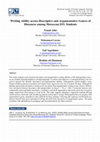
Electronic Journal of Foreign Language Teaching , 2023
This study compares and correlates descriptive and argumentative writing abilities of 80 undergra... more This study compares and correlates descriptive and argumentative writing abilities of 80 undergraduate semester six students studying English as a foreign language. To achieve this objective, a writing proficiency test was used to measure the students' descriptive and argumentative abilities. Subsequently, paired-samples t-tests, Pearson Product-moment correlation, and simple linear regression were run to analyze the data. Although the findings showed that descriptive writing scores are greater than argumentative writing scores, there is still positive correlation between descriptive and argumentative writing (r = .76, p < .001). Correlation between subcomponents such as grammar, mechanics, vocabulary, content & organization, and syntax across the two genres ranges respectively from strong to weak levels. The study suggests adopting a sequential teaching through which teachers could start with introducing students to descriptive writing. Subsequently they can progress with argumentative genre, identified as more difficult for these students. Following this sequence would enable students to transfer their good command of writing sub-skills from descriptive to argumentative genre. The study concludes with implications for pedagogy and recommendations for future research.
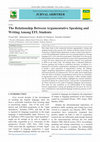
Jurnal Arbitrer , 2023
This study looks at the connection between argumentative writing and speaking among sixth-semeste... more This study looks at the connection between argumentative writing and speaking among sixth-semester EFL students at Moulay Ismail University in Morocco's English Studies department. In order to achieve this objective, a total of 80 undergraduate students who were learning English as a foreign language (EFL) were selected as participants. Participants were then given both speaking and writing examinations to assess their argumentation skills in these two areas. Regression and correlation analyses were performed in SPSS on the study's data. The findings show a substantial difference between speaking and writing in contentious discourse, in addition to a high positive association. Argumentative speaking was statistically proven to predict a great proportion of argumentative writing. The findings suggest integrating argumentative speaking and writing in teaching and assessment practices in a balanced way. The two skills can be taught along with each other to facilitate correspondences between the two modalities in argumentative genre. As the study concludes, it offers valuable insights into the implications of these findings, highlights the research limitations encountered during the research process, and provides recommendations for future endeavors in the realm of language pedagogy and assessment. This study not only contributes to our understanding of the interplay between argumentative writing and speaking but also paves the way for more comprehensive and integrated language instruction practices in EFL contexts.

This study investigates the relationship between public speaking and writing ability of EFL engin... more This study investigates the relationship between public speaking and writing ability of EFL engineerin g students. It was hypothesized that public speaking can predict writing scores due to the strong link that was assumed to interconnect the two domains. Working within Situated Learning theory (SLT) and Communication in the Disciplines (CID) theoretical framework, a quantitative correlational research design (N= 96) was adopted to correlate the two measures. The students delivered oral presentation s and wrote five-paragraph essays on various engineering issues. Public speaking was proven to be a significant predictor of writing ability due to the transfer of lexical, cohesive, grammatical, as well as content and organizational shared traits to the written products. Along with these findings, the study suggests incorporating disciplinary knowledge in oral presentations to enhance engineering students' oral communication skills which can, in turn, be transferred to their written products. The study ends with additional pedagogical implications for teachers and recommendations for future researchers.

JURNAL ARBITRER
This study looks at the connection between argumentative writing and speaking among sixth-semeste... more This study looks at the connection between argumentative writing and speaking among sixth-semester EFL students at Moulay Ismail University in Morocco’s English Studies department. In order to achieve this objective, a total of 80 undergraduate students who were learning English as a foreign language (EFL) were selected as participants. Participants were then given both speaking and writing examinations to assess their argumentation skills in these two areas. Regression and correlation analyses were performed in SPSS on the study’s data. The findings show a substantial difference between speaking and writing in contentious discourse, in addition to a high positive association. Argumentative speaking was statistically proven to predict a great proportion of argumentative writing. The findings suggest integrating argumentative speaking and writing in teaching and assessment practices in a balanced way. The two skills can be taught along with each other to facilitate correspondences be...
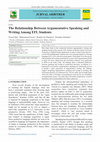
The Relationship Between Argumentative Speaking and Writing Among EFL Students, 2023
This study looks at the connection between argumentative writing and speaking among sixth-semeste... more This study looks at the connection between argumentative writing and speaking among sixth-semester EFL students at Moulay Ismail University in Morocco's English Studies department. In order to achieve this objective, a total of 80 undergraduate students who were learning English as a foreign language (EFL) were selected as participants. Participants were then given both speaking and writing examinations to assess their argumentation skills in these two areas. Regression and correlation analyses were performed in SPSS on the study's data. The findings show a substantial difference between speaking and writing in contentious discourse, in addition to a high positive association. Argumentative speaking was statistically proven to predict a great proportion of argumentative writing. The findings suggest integrating argumentative speaking and writing in teaching and assessment practices in a balanced way. The two skills can be taught along with each other to facilitate correspondences between the two modalities in argumentative genre. The study ends with further implications, research limitations and recommendation for future endeavors.

Canadian Journal of Applied Linguistics
This study aims to examine the relationship between the productive knowledge of some lexical and ... more This study aims to examine the relationship between the productive knowledge of some lexical and phraseological indices and the quality of English as a Foreign Language (EFL) learners’ writing. A sample of 120 expository essays, written by semesters 1 and 5 university students in a less proficient EFL context, are rated by human evaluators and automatically examined for the target indices. The results show that, unlike the index of lexical diversity, both indices of content word frequency and range could significantly discriminate between different proficiency levels. For the phraseological indices, both the proportions of rare and frequent bigrams yielded between-group differences, with higher proficiency students performing significantly better in both categories. Using a regression analysis, the results show that the use of rare and contextually restricted content words and the production of larger proportions of rare and frequent bigrams could be considered indicators of better ...

Canadian Journal of Applied Linguistics, 2023
This study aims to examine the relationship between the productive knowledge of some lexical and ... more This study aims to examine the relationship between the productive knowledge of some lexical and phraseological indices and the quality of English as a Foreign Language (EFL) learners' writing. A sample of 120 expository essays, written by semesters 1 and 5 university students in a less proficient EFL context, are rated by human evaluators and automatically examined for the target indices. The results show that, unlike the index of lexical diversity, both indices of content word frequency and range could significantly discriminate between different proficiency levels. For the phraseological indices, both the proportions of rare and frequent bigrams yielded between-group differences, with higher proficiency students performing significantly better in both categories. Using a regression analysis, the results show that the use of rare and contextually restricted content words and the production of larger proportions of rare and frequent bigrams could be considered indicators of better writing proficiency. The study suggests implications for the teaching of EFL.
Receptive Vocabulary Size of EFL Learners in Moroccan High Schools, 2019
Thanks should also go to the-Association Provinciale d'El Jadida pour les Oeuvres Culturelles‖ fo... more Thanks should also go to the-Association Provinciale d'El Jadida pour les Oeuvres Culturelles‖ for partly funding the publication of these proceedings. Special thanks go to Prof. Erguig for taking care of the technical aspects and also for the major role he played in the publication of these proceedings.
B. Ait Hammou, 2022
The development of EFL Learners' Syntactic Knowledge … use of rare constructions enhances raters'... more The development of EFL Learners' Syntactic Knowledge … use of rare constructions enhances raters' judgements of students' writing quality.

Using a written corpus of 529 texts, this study is the first to examine undergraduate university ... more Using a written corpus of 529 texts, this study is the first to examine undergraduate university learners’ productive bigram knowledge in the Moroccan EFL context. Internationally, while previous research focused on strongly associated bigrams, the current study adopts a continuum perspective and examines strongly and moderately associated bigrams as well as wrong word combinations, using a cross-sectional approach with three adjacent groups. The analysis of strongly and moderately associated rare bigrams shows that learners tend to increase their MI mean score towards the production of more strongly associated bigrams, as we compare lower to upper proficiency
groups. For frequent bigrams, the results show that there is a reversed effect of proficiency on learners’ performance as learners have a tendency to produce less fixed frequent combinations as they gain better proficiency, which suggests that they are using frequent word combinations in novel, more flexible ways. For wrong combinations, the three groups manage to form more accurate combinations as they move towards higher proficiency levels both when rare and frequent bigrams are considered. The results indicate that the development of phraseological knowledge follows a continuum trajectory. The study has implications for learning and teaching EFL.
Keywords: bigrams; collocations; EFL; writing; phraseological knowledge

While frequency of occurrence and lexical diversity are common measures of lexical proficiency, v... more While frequency of occurrence and lexical diversity are common measures of lexical proficiency, very few studies have examined range along with these two other lexical indices, especially in EFL contexts. Using a sample of 529 undergraduate EFL learners’ essays, the present study examined the development of three indices of lexical proficiency (word frequency, range and lexical diversity) across 3 different proficiency levels. No similar study has been conducted so far in the Moroccan context, which makes this study a valuable contribution to a better understanding of university learners’ productive lexical knowledge. Unexpectedly, although frequency is an established measure which can successfully show differences in learners’ proficiency, the results of this study indicate that at the productive level, the range of content words and lexical diversity might better reflect differences among learners of different proficiency levels. While word frequency was stable among the three gro...
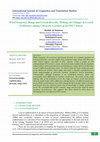
International Journal of Linguistics and Translation Studies, 2021
While frequency of occurrence and lexical diversity are common measures of lexical pro... more While frequency of occurrence and lexical diversity are common measures of lexical proficiency, very few studies have examined range along with these two other lexical indices, especially in EFL contexts. Using a sample of 529 undergraduate EFL learners’ essays, the present study examined the development of three indices of lexical proficiency (word frequency, range and lexical diversity) across 3 different proficiency levels. No similar study has been conducted so far in the Moroccan context, which makes this study a valuable contribution to a better understanding of university learners’ productive lexical knowledge. Unexpectedly, although frequency is an established measure which can successfully show differences in learners’ proficiency, the results of this study indicate that at the productive level, the range of content words and lexical diversity might better reflect differences among learners of different proficiency levels. While word frequency was stable among the three groups, indices of range and lexical diversity reflected better lexical knowledge in higher proficiency levels. We concluded that in EFL contexts, range and diversity might be better measures of proficiency. This suggests that there should be more focus on developing these two aspects in EFL classes.
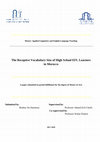
This study investigates Moroccan secondary school EFL learners’ receptive vocabulary size. It als... more This study investigates Moroccan secondary school EFL learners’ receptive vocabulary size. It also examines how these learners’ receptive vocabulary knowledge develops after one year of instruction. The study used Meara’s (2010) edition of EFL Yes/No vocabulary test. The test was administered to two secondary school grades: the Common Core and 2nd year of the baccalaureate over two different periods. The first test was administered in October to total number of 460 students. The second test was administered in May to total number of 408 students. The students who took both the first and the second test were from intact groups of different secondary schools which were randomly selected. The results of the study show that the pattern of vocabulary learning adheres, in general, to word frequency patterns. Except in band 3, in which learners always performed slightly better than band 2, learners’ knowledge slopes down from band 1 to band 4 for the Common Core and from band 1 to band 5 for 2nd year bac. (Bac2). In terms of vocabulary size, the Common Core learners have been found to start the school year with a vocabulary size of approximately 793 and ended with 982 words. The results, however, show that not all Common Core majors gained the same amounts of vocabulary. For Bac2 learners, the results of the present study show that these learners increased their receptive vocabulary from 1,516 words at the beginning of the year to 1,789 at the end of the year. This indicates that Moroccan secondary school learners end their secondary school with a receptive vocabulary size which is less than 2,000 words. All the three majors of Bac2 developed their vocabulary size, though they performed significantly differently. The results of the present study did not show any statistically significant effect of gender on learners’ receptive vocabulary size. Both males and females appeared to develop their receptive vocabulary size in very similar ways. Finally, learners’ reported access to/use of the internet, however, was found to have some effect on learners’ receptive vocabulary size. Learners who reported having access to/using the internet in English language learning performed significantly better than learners who reported that they don’t have access to the internet.
Keywords: receptive vocabulary size; secondary school; frequency; grade; gender; major; English as a Foreign Language.
Drafts by Brahim Ait Hammou
Recent developments in computational and corpus linguistics has brought into lights a variety of ... more Recent developments in computational and corpus linguistics has brought into lights a variety of aspects which remained unexplored in languages such as English and French. Studies on these languages have touched on a variety of areas including syntax, vocabulary, phraseology, etc., and they have contributed to a better understanding both of how language develops and how learners learn it both in natural and instruction-based contexts. However, studying these linguistic aspects of Arabic language is still an area that











Uploads
Papers by Brahim Ait Hammou
groups. For frequent bigrams, the results show that there is a reversed effect of proficiency on learners’ performance as learners have a tendency to produce less fixed frequent combinations as they gain better proficiency, which suggests that they are using frequent word combinations in novel, more flexible ways. For wrong combinations, the three groups manage to form more accurate combinations as they move towards higher proficiency levels both when rare and frequent bigrams are considered. The results indicate that the development of phraseological knowledge follows a continuum trajectory. The study has implications for learning and teaching EFL.
Keywords: bigrams; collocations; EFL; writing; phraseological knowledge
Keywords: receptive vocabulary size; secondary school; frequency; grade; gender; major; English as a Foreign Language.
Drafts by Brahim Ait Hammou
groups. For frequent bigrams, the results show that there is a reversed effect of proficiency on learners’ performance as learners have a tendency to produce less fixed frequent combinations as they gain better proficiency, which suggests that they are using frequent word combinations in novel, more flexible ways. For wrong combinations, the three groups manage to form more accurate combinations as they move towards higher proficiency levels both when rare and frequent bigrams are considered. The results indicate that the development of phraseological knowledge follows a continuum trajectory. The study has implications for learning and teaching EFL.
Keywords: bigrams; collocations; EFL; writing; phraseological knowledge
Keywords: receptive vocabulary size; secondary school; frequency; grade; gender; major; English as a Foreign Language.